#first encounter—flashback sequence—in the years serving the Emperor
Explore tagged Tumblr posts
Text
...what the Admiral wants, the Admiral gets...
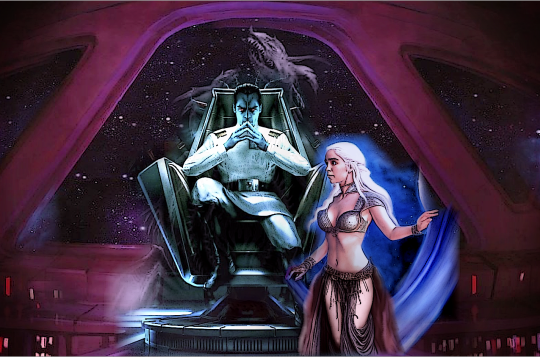
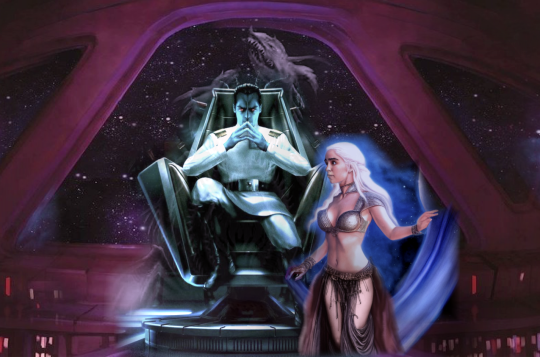
#Thrawn#Grand Admiral Thrawn#Rhyanon ferch Garowen#Star Wars#the Keltiad#Firefly-Serenity#crossover#Lattice of Infinity#Eulogy of Dead Kingdoms#concept art#space opera#first encounter—flashback sequence—in the years serving the Emperor
6 notes
·
View notes
Note
i DO actually wanna know how youd make kotor 3 !!!!!
this ask has been sitting on my inbox for so long on PURPOSE! i wanted some time to re read the revan book + watch some swtor gameplays so i could give a concrete answer about why the book and swtor arent satisfactory and what i would do instead (im not like. a storytelling god so i this is just my PERSONAL idea). under the cut!
to begin with, what's wrong with revan the book and swtor, mai?
i am very fond of swtor i think it was such a nice idea to have an "open" world game set in star wars old republic time. but ultimately, it was not a good conclusion to revan and meetra's storyline! now, i don't really know what happened in the development of the third kotor game (if there ever was a plan for one) but it's clear they dropped the ball on that and decided to start a whole different project. i don't think we can blame disney for that one, because it was announced on 2008, launched in 2011, and disney had just bought star wars that year. so who knows.
the thing is that it's painfully evident that a bunch of the story that was gonna be in the third game, ended up in the book + misc parts of swtor. much of the book feels like a gameplay.
now, it was clear when the book was planned that they wanted to keep revan's story open so when the game came out, they could have a cool Revan storyline so he could make a cool villain appearence and draw in some of that kotor nostalgia. which ehhhhhh. uh. i don't really think did any favors for revan's character. he didn't have a satisfactory arc (I'm not saying "a happy ending" because good arcs aren't always happy) but at least some closure?
revan went through many big events in his life. we didnt need to keep his ass in stasis for his fun villain moments 300 years later. we already had what we wanted from him: jedi turned sith turned jedi again to defeat a terrible threat. that was it we could have let it there and it would have been cool! but then they decided to drag and drag his story just to leave him right where he was before. he just suffered a little more in the in-between.
you could say he finally redeemed himself of all of his crimes this way, but wasn't that the whole purpose of the first kotor game (and would have been the purpose of the 3rd?)
swtor does not centre revan in his own narrative. he's a side character for the player to experience. and look, i get it, we've had a different protag on each game, why not have another one in this one. well, because the protagonist has no personal relationship with revan. meetra was one of his closest friends, and fought with him. there is a connection that can be exploited. but the swtor protagonist is just some guy 300 years in the future who happens to stumble into revan and his life. not even his descendants get to fully interact with revan.
also, there is the fact that revan is not the centre of the game itself, only of a particular storyline. and it's weird, because swtor could have happened without revan's involvement.
ms. meetra surik, ms. bastila shan, women of the world I'm sorry
so it's no news that star wars is misogynistic as fuck right. cause it is.
so you decide to make your gender neutral protagonist a guy. then you decide to make your other gender neutral protagonist a woman. cool. now let's guess who gets underdeveloped, turned into a plot device without reason, and promptly fridged in the most unceremoniously fashion just to fullfil some manpain moments. which one do you think got that treatment.
i know the revan book is supposed to be about revan, but why make meetra go through a whole arc just to undermine her character and turn her into the faithful servant of the guy? she leaves everything behind for him, sacrifices herself for him, hell not even dead is she not serving the guy. and she was the second game’s protagonist! she beat up a bunch of powerful people and now she’s just meh, there? she had so many interesting ways to interact with revan (meeting kreia, revan’s first master, encountering another force consuming entity, etc.)
meetra went through a whole arc about dealing with the guilt of doing something horrible and having the consequences of it cut her from the force. we see her broken, then slowly come back to the world and reconnect herself with the force, then stop running and face the consequences of her role in the war. thats such a cool character with tons of potential! and nothing happened!
then we got bastila who is. a whole deal. so you make her go through a “promising jedi who defeated revan, to questioning reluctant companion, to fell into the dark side, to was redeemed thanks to her bond to revan, who helped her come back because he’d been through the same experience” arc, and then you decide to push her to the side to have a baby?? which is... its clear that the writer didnt know what to do with her (or with the other characters outside of canderous) so hey, lets get her to marry revan and have a baby.
my ideal kotor 3
to preface, im not a game developer, so some of my choices could be stunted by what a kotor rpg can do lol. of course, it would follow the same mechanics and have the same format as the first two, because consistency!
the fun way to start the game, would be from scourge’s perspective. we get to play as a sith! i’d even say you get to change scourge’s name and gender and looks (i know sith have different looks)
in scourge’s storyline, we get from his arrival to normound kaas, to his talks with nissyris, to his missions working for her. in some of these, we can make scourge lean into the dark or the light side! fun! plus we get some exposition with dialogue options. it all continues untill we get to nissirys story about the emperor. we get a fucked up cutscene of his childhood and then BOOM when its over, we see revan waking up from a nightmare and their pov starts.
ok, as for revan’s story, since we’d have to pick it up from where kotor ended, i’d have a little cutscene of revan back into the ebon hawk, with bastila, and them telling the crew to take them to courascant. then cut to a council meeting where revan and bastila get scolded in private, then rewarded by the republic. i would also like to see some revan mournink malak’s death mayhaps. since he was their childhood friend and all.
i would 100% scrape the marriage and two years passed part. as the book said, the council had no use for revan aside from the legend(tm), so why would they stay in courascant. revan was very alienated from the jedi at that point, despite being back in the “light side”
then like, to revan asking around for meetra and other jedi from the mandalorian wars, we can cash in that atris cameo, then revan starts to have these visions about the sith emperor, and maybe we could get a playable dream sequence about revan’s fight with mandalore the ultimate (I KNOW I WOULD LIKE TO SEE IT.) and we get the whole exposition to mandalore telling revan that the sith are behind it all. i believe we should get a bunch of these flashback/dream sequences of revan’s past doing shit. cut to revan burying the mask in a planet, then back to the present. we see a bunch of mission and juhani scenes trying to reach him, but he keeps pushing them away. revan and bastila meet canderous, travel to the ice planet, meet clan ordo (god i love clan ordo) you get the whole quest, you decide weather to spare veela or not, maybe you get a cheeky mandalorian companion (force sensitive mando oh?) and leave canderous behind.
we can visit like, a couple more planets searching for clues maybe, etc. then when reaching nathema, you are forced to go alone as revan, get to explore nathema a bit (raiding ancient location yay) nathema as a location can be so fun because you can have it weaken you hp bar and also you cant use the force (which, in game is pretty cool)
then we get to scourge and nyssiris arriving to the planet, they fight but since theres two of them and revan doesn’t have the force, they beat the shit out of them, and while running away, they get in a fight with bastila and the companions in the ebon hawk (ebon hawk shooting game my hated). bastila manages to get a glimpse of revan’s thoughts before they take them away. but the ebon is so ruined it takes bastila, t3 and the mandalorian a while to fix it, and they get stuck into the unknown regions for a while. the ebon hawk is left in an outer rim planet with t3 fixing it, bastila and the mandalorian run back to the jedi council, only to get caught in the middle of the jedi civil war. we can have bastila choosing to hide in courascant and trying to make sense of what she saw, reading texts about the sith empire, trying to plot a course to where they took revan (more atris! but shes pissed at her now)
cutscene to meetra’s pov, leaving malachor v behind, getting calls from everyone at the hawk (atton my beloved) but just as she’s leaving she gets a force message from revan, calling for her to find him and sending visions of normound kaas. then, through her force bond with visas, she tells her not to go because they’re gay and in love and whatnot.
then boom, she gets intercepted by bastila’s ship, with the mandalore and the other mandalorian (yes i do love having a bunch of mandos on board) and they go on their way to find revan.
now i want there to be an underlying message of “we can’t take our friends with us because we have to do this ALONE we’re powerful JEDI we don’t need our FRIENDS.” meetra gets asked if she wants to bring any friends and she’s like “no. we have to do this alone.” along the game you get constantly contacted by other game characters, you get the chance to talk to them or ignore them.
so, we get back to nathema, and meetra has a whole “holy shit this is just like darth nihilus but ten times worse. but i beat darth nihilus. i can do this!” then she finds peace in this place without the force, we get a whole speech about how the odds arent against them, they find a way to normound kaas, and get going.
in normound kaas i thought about them getting a whole mission about how to infiltrate the citadel, only to get helped by scourge. he joins the party, we get a little flashback of all the years he spent trying to make revan remember and they storm the citadel. we get to fight the dark council members, fun! then we get to free revan and the game switches povs. bastila hands the mask to revan and he has a cool “yes im revan im pretty cool” then a nice heartfelt yet rushed reunion with everyone.
then have a small CONVERSATION WITH MEETRA where she talks about the sith triumvirate she defeated and revan is impressed with her and is like “we are the last hope of the jedi, we’ve learned to walk between light and dark, we’ve done horrors but we can still make things right, our experience has made us more powerful etc.
then they fight the imperial guard, ALL OF THEM, meetra revan and scourge make it into the throne room, they all fight the emperor. meetra shows the emperor that she has seen the void, she has cut herself from the force, and she’s not afraid of him, revan supports her, talks about redemption and hope and NOW.
NOW. how the alternate endings could go:
if you decide to take scourge through the light side, he manages to form a forcebond with meetra and revan since they’ve both teached something about the duality of the force, they get 100% stronger, but its still not enough. UNTIL. a bunch of ships (jedi and mandalorian, even non republic ships) arrive to dormound kaas, the gangs from each game storm the room and together they make the emperor and his guard a bunch of punching bags. they beat him! (unknow to them, this was a backup body because the emperor can do weird shit like that, and has only debilitated his plan, but he’ll come back dont worry). then they fly back to the republic, to tell the chancellor about the sith threat, and preparations for the war begin. meetra and revan get to live happily ever after for a while, then they die away from the jedi or the sith (waaah im thinking about them helping canderous rebuild the mandalorians, and them doing it since they killed so many mandos in the war)
BECAUSE IN THE END KOTOR IS ABOUT LEARNING TO PROCESS TRAUMA AND RECOGNIZE YOUR MISTAKES AND LIVE WITH THE GUILT WHILST TRYING TO FIX THE MISTAKES YOU MADE ALONG THE WAY. AND ALSO TO HEAL FROM TRAUMA YOU NEED A SUPPORT SYSTEM SO EVEN THOUGH IT MAKES SENSE TO YOU YOU SHOULDNT PUSH PEOPLE WHO LOVE YOU AWAY. AND THINGS AREN’T BLACK AND WHITE ITS COMPLICATED SO YOU DONT END UP BACK ON SQUARE ONE YOURE A CHANGED PERSON.
or
if you decide to dark side scourge further, he betrays revan and meetra, they all die, and the emperor unleashes his angry lightning or whatever on everyone + a bunch of visions of all the enemies of past mocking them, and their loved ones suffering. and since you’ve had that “im not calling my friends bullshit” no one comes, you die there, and the emperor is only stalled for a few years. swtor ensues. scourge becomes the emperor’s hand.
now you could of course bring revan and meetra up in swtor, but maybe only as force ghost guides, or have some of the other characters of the game have relevance (visas tries to heal the miraluka planet 2021)
WELL THAT WAS A LOT OF WORDS. HOPE THIS IS SATISFYING ENOUGH
#this is bonkers but ive been thinking about it since 2011 so.#wow 10 years since i played kotor. wretched little game.#also if i switch pronouns midway its because it would make it clearer#kotor 3 rewrite
31 notes
·
View notes
Text
A Saga in Ruins: How the sets reflect the empty nostalgia of the Sequel Trilogy
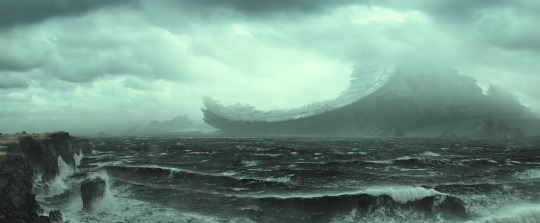
To the great surprise of many fans, the Skywalker Saga ended in the ruins of the Lars moisture farm on Tatooine. Perhaps this was intended to be circular, to be a coming home of sorts, but it was an odd choice for many reasons. Why would the youthful heroine find herself in an old, empty home to which she had no real connection, instead of on a verdant green world that she had so clearly craved earlier in her journey? Wouldn’t a place full of life be more fitting for a young woman starting a hopeful new chapter?
Of course, the dirty little secret is that there is nothing hopeful about the end of the Skywalker Saga. In fact, if we look across the Sequel Trilogy, we can see the theme of destruction, aging, death, and decay in many of the settings. Notably, the only sets that look truly new are the interiors of the First Order ships, and the rich luxury world of Canto Bight, but these sleek structures actually contain a moral rot.
It was appropriate for the Prequel Trilogy to be filled with shiny new sets as the Republic and Jedi were at the height of their power. The beauty was intentional, both so that we would appreciate the civilization that would be lost with the ascension of the Dark Side, and so that we would see it as the deceptive shell hiding the moral destruction within. In the Original Trilogy, the sets have an older, worn appearance, but are rarely what could be termed “ruins.” Given that the Sequel Trilogy takes place 30 years later when the galaxy has presumably been rebuilding since the Galactic Civil War, why then are SO many of the events set in ruins, or in places that become ruins?
Ruins in The Force Awakens
The first movie of this final trilogy started on Jakku, a ruin of a world home to the destroyed imperial fleet that made a last stand at the end of the Galactic Civil War. In the first scene of the film, new ruins are created when First Order troops destroy a village. Not long after, Poe and Finn crash-land into the desert, the ruin of their TIE fighter swallowed up by the sand. Later, we meet Rey, a lonely scavenger who is picking at the guts of a downed Imperial Star Destroyer. The shots in this sequence emphasize the scale of these ruins, along with the utter emptiness of the desert. Next, we see Rey in a little trading outpost cobbled together from disparate parts. She gazes dolefully at an elderly woman working the same task that she is, clearly seeing in the aged woman her own barren and lonely future. Finally, she travels to her own home, which turns out to be a collapsed AT-AT Imperial Walker. In an endearing but somewhat macabre moment, Rey dons the helmet of a Rebel X-Wing pilot. In a parallel scene, Kylo Ren is seen talking to the charred helmet of Darth Vader, beseeching his grandfather to speak to him. It’s nostalgia, yes, but for a past that is ruined, destroyed, and dead.

She next escapes Jakku in the Millenium Falcon, which might not be considered a ruin since it still (barely) flies, but it has clearly seen better days. Rey heaves the decrepit freighter through yet more bones of downed starships, finally escaping Jakku only for the Falcon to malfunction again. Han and Chewie, elderly yet vigorous as ever, join Rey and Finn and they all travel to Takodana, where Maz Kanata lives in a castle. From there, they witness the destruction of the Hosnian system, and then the First Order arrives and completely destroys Maz’s castle, creating yet another pile of rubble. The group next travels to D’Qar, a Resistance base nested in an old Rebel Alliance base from the Galactic Civil War three decades prior. Again, everything is old, aging, and recycled; nothing is new.
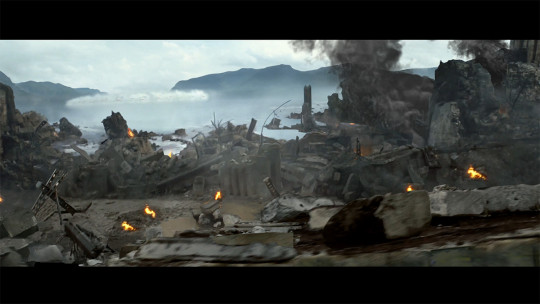
Starkiller Base is shiny and new, but it is also a tool of destruction, and before long it too collapses into space debris like Alderaan and Hosnian Prime. Meanwhile, we learn that the Skywalker-Solo family itself is in ruins, with Han and Leia split up, their son Ben fallen to the Dark Side, Luke missing in exile, and Han soon killed by his own son. Rey then travels to Ahch-To, where stand the ruins of the first Jedi Temple, to find the aging and bitter Luke Skywalker.
Ruins in The Last Jedi
On Ahch-To, Rey comes to find that the Jedi religion itself is in ruins, with their ancient texts abandoned and their one avatar, Luke, having cut himself off from the Force itself. In the course of her stay, she shoots a hole through the wall of her hut, slices through a large rock on the island, and emerges from the ruin of a hut that Luke explodes when he finds her with Ben Solo. Though Ahch-To is teeming with life, death is equally present, with Luke chatting with Force Ghost Yoda and watching the Jedi tree burn.
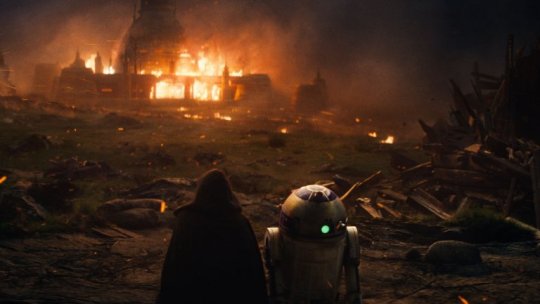
Further, Luke is a ruin of his former self, his moral certainty destroyed by regret. In the series of flashbacks to his last encounter with Ben, we see the hut collapsing, Luke rising from the rubble later, and his training temple in flames. Luke’s legacy, his relationship with his nephew, and now the physical manifestation of both is in ruins, as well. Even his X-Wing, once a symbol of his daring, sits submerged in water, presumably unusable and possibly scavenged already for parts.
On the Supremacy, the shattering of the Skywalker legacy is made visible in the breaking of Anakin’s lightsaber in the destroyed throne room. The ship itself lies in ruins after the battles that have raged across the ship and Admiral Holdo’s brave sacrifice, and even Ben and Rey’s fledgling relationship has been shattered by the end of the sequence.
Meanwhile, after the destruction of their fleet, the Resistance escapes to Crait, to yet another old Rebel Alliance base in the hope of escaping the First Order. Their speeders are so decrepit that Poe manages to punch a hole through one with just his foot, and the remaining forces are decimated before he makes the decision to pull back. With their massive laser cannon, the First Order punches a hole through the blast door to the base, effectively destroying it and rendering it unusable as a defensive position. By the end of the Crait sequence, the Resistance, their fleet, their base, and the central relationship of the movie between Rey and Ben are all in ruins.
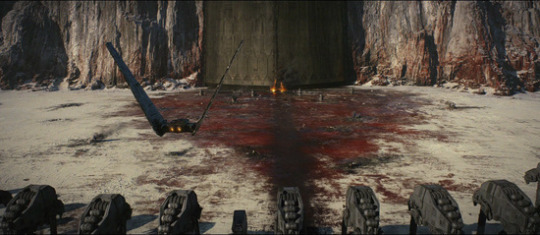
Though destruction and ruins abound in The Last Jedi, the framing is notably different from the other two films because the purpose of all this imagery is to show hope for the future springing from the rubble. Rey states this theme explicitly when she’s meditating for Luke on Ahch-To, saying she sees “death and decay that feeds new life.” The breaking of Kylo Ren’s mask and the legacy lightsaber are intended not as endings but as steps in the cycle of rebirth and renewal. Luke manages to shed his broken shell and become the young hero he once was, later achieving transcendence as he passes whole into the Force. Despite the massive wound dealt on Crait, the salt cleanses and covers the carnage, suggesting rebirth with womb-like imagery. Ruins in The Last Jedi tend to serve less as nostalgic settings and more as visual symbols of brokenness that must and will be healed.
Ruins in The Rise of Skywalker
As the final film of the sequel trilogy opens, we see Kylo Ren fighting a group of cultists, whom the TROS Visual Dictionary tells us are Vader loyalists. Leaked images from the art book and cut scenes suggest that this scene actually takes place in the shadow of Vader’s castle, also now a ruin in the absence of its dark master. Using the Sith wayfinder, Kylo flies to the Dark Side planet of Exogol, entering what appears to be an ancient temple of the ruined Sith culture. There he finds the resurrected but still deathlike Palpatine, who is clearly such a ruin of his former self that he must be kept alive by machinery and dark arts.
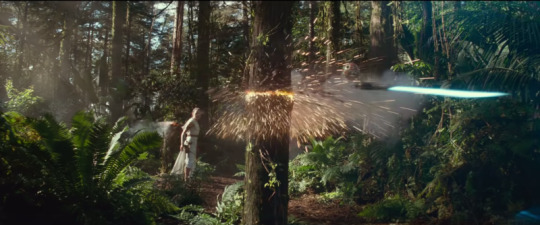
In returning to the forested, hidden Resistance base, Finn and Poe nearly destroy the Falcon yet again, with the old ship catching fire as she lands among a small collection of similarly ancient ships that appear to be in questionable flight condition. While running her Jedi training course, Rey uses the same pilot’s helmet and training remotes that Luke used over 30 years earlier to practice her skills, and cuts down a number of trees in the process, leaving a path of destruction in her wake. Not only does the continued use of old, OT-era objects confound logic, but the wanton destruction of the natural world seems at odds with the Jedi philosophy’s reverence of the life which creates the Force.
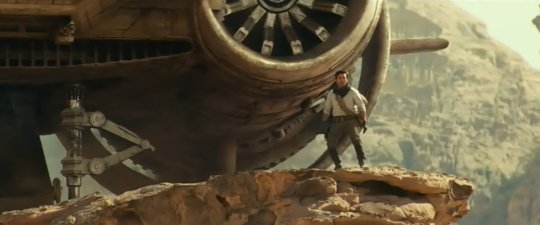
Rey’s vision leads her to the barren desert world of Pasaana, where she meets the now-elderly Lando Calrissian, then finds the wreck of the ship that pursued her family when they were fleeing the resurrected Emperor. In the ruin of Ochi’s ship, Rey finds D-0, a broken and abandoned droid who yet again mirrors all the broken and abandoned characters (literally, ALL of them) in the Sequel Trilogy. When Kylo Ren appears, Rey first destroys his TIE Whisper, then when he crawls from the wreckage, the two have a Force tug-of-war over a transport ship which ends in Rey destroying it, as well. Of course, it later turns out that Chewbacca was not aboard that transport, thus continuing the pattern in this film of laying waste to the new planets, ships, and characters that were created for the sequels, while those from the original trilogy are miraculously preserved.
The gang next travels to Kijimi, where they apparently need to destroy C3-P0′s memories in order to unlock his ability to translate an ancient Sith language. As with Chewie, this is merely a temporary “death,” and Threepio’s memories are restored later. Kijimi, unfortunately, is not so lucky, and it is rather unceremoniously blown up, like Alderaan and Hosnian Prime. It seems that even with their allies, the Resistance heroes leave nothing but destruction in their wake.

Rey and friends next land on another moon of Endor, and the poor Falcon takes another beating. While her friends work yet again to repair the old ship, Rey escapes alone to the most imposing ruins of the entire film, collapsed shell of the second Death Star from Return of the Jedi. Calling back to not only Luke’s ordeal there, but also Rey’s own origins scavenging in the carcasses of Imperial Starships, the partially-submerged battle station serves as the backdrop for still more violence and destruction. When Ben Solo arrives, Rey engages him in another duel, which ends with Leia dead and Ben mortally wounded. Though Rey heals Ben, she next flees to Ahch-To, abandoning him and taking his TIE Whisper with her.
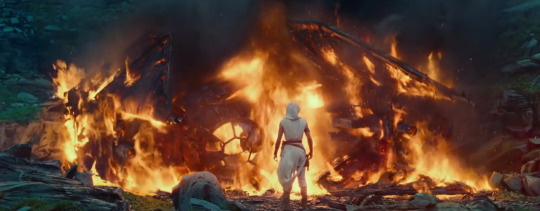
On Ahch-To, Rey burns the TIE, standing before the flaming ruins and attempting to throw her lightsaber into the fire. Luke stops her, then leads her to an abandoned hut to find Leia’s lightsaber, a remnant of her aborted Jedi training. Lastly, Luke raises his X-Wing from the water, offering it to Rey inexplicably space-worthy and no worse for the wear having been underwater for the better part of a decade and being at least 35 years old.
Finally, all the characters converge on Exogol, where they continue to engage in as much destruction as possible, including the apparent annihilation of an entire Sith civilization who lived on the planet as part of Palpatine’s Final Order. Ben Solo also arrives on the planet to help Rey (in another OT-era fighter that is miraculously space-worthy and moreover made it across the galaxy WITHOUT A HYPERDRIVE), but Palpatine sucks the power from him and then throws him painfully down a chasm, leaving his body broken. The climactic sequence ends with thousands dead, ships destroyed, and even Rey dead (or something) on the ground. Ben drags his broken body up and across the wreckage of the arena, and dies after resurrecting her, thus ending the Skywalker line.

After a celebratory hug with her friends, Rey flies the Falcon to Tatooine, to the literal ruins of the Lars Homestead. This is the place we last saw belching smoke as Owen and Beru’s charred remains splayed grotesquely across the scene of Luke’s destroyed childhood. Recalling again Rey’s beginning scraping a meager and lonely existence from battle wreckage, she slides down a sand dune on a loose piece of debris, and precociously explores the place. Finally, she buries Luke and Leia’s lightsabers (further cementing this place as a graveyard since Shmi is also buried here along with the Lars), and declares herself to be a Skywalker, the heir to these ruins.
Nostalgia as Love of a Dead or Imaginary Past
So, what does it all mean? If the Sequel Trilogy relies on ruins as a setting more than the other two trilogies, why does that matter? Isn’t it just paying homage to all the stories that led to the saga’s conclusion? Doesn’t it simply tie everything together?
Most critics and fans agree that the Sequel Trilogy relies heavily on nostalgia. In particular, JJ Abrams is often criticized for using nostalgia to such a degree that many of his films are direct copies of the stories they’re referencing: Super 8 is a mash-up of films like E.T. and Stand By Me, Star Trek: Into Darkness is a copy of The Wrath of Khan, The Force Awakens is nearly identical to Episode IV: A New Hope, and so on. Nostalgia is defined as:
“A sentimental longing or wistful affection for the past, typically for a period or place with happy personal associations.”
Most of Abrams’ movies succeed in creating this feeling because they rely on a shared cultural childhood memory. We fondly remember iconic moments from the films we loved as children, so seeing those moments again creates a feeling of remembered happiness. These movies encourage the viewer to recall how they felt the first time they saw certain images by repeating those images.

The first problem with this approach is that nostalgia is for the audience, not for the characters. The believability of the characters’ actions suffers when they are forced to act out scenes from a story that is not their own, from lives and perspectives that are not theirs. The audience might love seeing a lightsaber battle because that’s quintessential Star Wars, but if the two (or more) characters have no logical reason to fight other than as a spectacle for the audience, then the scene will lack any emotional depth. Likewise, a character revering someone whom they either barely knew or openly loathed makes no sense. In the case of settings or props, characters must respond to them in a way that is believable based on their actual history (or lack thereof) with the place or object. If the main characters of a story function only as a sort of modern Greek chorus, mirroring the nostalgic reactions of the omniscient audience, then they fail to be characters at all and become the most reductive versions of a self-insert.
This video explains the problem well, from 7:09 to 10:58 (the whole video is good but fair warning that not all of his takes align with what I believe about Star Wars, especially as regards Kylo Ren/Ben Solo):
youtube
Another problem with this reliance on nostalgia is that in order to speak to a shared childhood experience, everyone in the audience must have had similar childhoods, or at least belong to the same generation so that they all fondly remember the same things. This is necessarily exclusive, as different generations have vastly different collective experiences and memories. The members of the audience who were children at the time of the Original Trilogy’s release or shortly after grew up in a very different world than those who were children during the release of the Prequel Trilogy, or from the generation living through childhood now. Some things that older generations remember fondly carry uncomfortable or even traumatic associations for younger generations, so something intended to be nostalgic will not impact all audiences in the same way.
The legacy saber is a great example of this: an older Original Trilogy fan might be delighted to see Luke’s inaugural lightsaber from the very first Star Wars film being passed on to the new generation, but a younger fan who grew up with the Prequels might see it as a tainted symbol of Anakin’s fall to the dark side and a weapon stained with the blood of innocent younglings. A family sword meant to press the nostalgia button in The Force Awakens instead invokes a feeling of dread and horror in fans with different associations. While Rian Johnson mentions deliberately referencing the Prequels in his creation of The Last Jedi, JJ Abrams and Chris Terrio make no secret of the fact that they don’t acknowledge those films, and it shows.

Lastly, Star Wars has always been a story of youth, of coming of age, growing up, and becoming one’s own person. Luke’s story in the Original Trilogy was about him learning who he was independently of his father and mentors. He is merely a boy, young and defiant, and through his own mistakes he learns how the elder generation was wrong, resolves to do better, and thereby redeems them. Anakin’s story was similar, except that he was unable in his youth to learn the right lessons from the failures of his mentors, his defiance taking a more destructive form. In contrast to both of them, Rey learns.... that all her mentors and parental figures were right all along. In the end, she defies no one, discovers no new and better way, and ultimately brings nothing new and different to the galaxy. She brings no peace or renewal, adopting a legacy of death and destruction to cap a life that has featured only the old, dead, and destroyed.
This is where Disney and Abrams tip their hand and the true philosophy underpinning the Sequel Trilogy is revealed: in an effort to appeal to the nostalgia of older Star Wars fans, they fail to tell a story of youth and instead offer an orgy of death-worship and aesthetic decay. Rather than having the Star Wars conclude with Star Peace, the final trilogy seems to say “Weren’t those wars great? Don’t you miss them? Don’t you want to be reminded of all those wars?”

In her book The Future of Nostalgia, Svetlana Boym defines the term a little differently than the dictionary:
"Nostalgia (from nostos - return home, and algia - longing) is a longing for a home that no longer exists or has never existed. Nostalgia is a sentiment of loss and displacement, but is also a romance with one's fantasy."
Boym points out that memory is often faulty, and that fond recollection is often a reaction to current despair. If things are bad now, it is natural for us to imagine a more comforting past, as with popular references to “the good old days.” In fact, another translation of the root algos is “pain,” thereby associating the return home with pain. Is it pain that prompts our longing to return home? Pain that creates the fond memory of home in the first place? Perhaps home itself is a source of pain, and so our minds construct an imaginary home that is better than the reality. In any case, it is typical that our rose-colored glasses distort the truth of what we long for, so the danger of nostalgia is a disassociation from truth.
One of those truths that we might deny in our fantasies is the ephemeral nature of human life and experience. All things age, decay, and ultimately cease to be. They may be evergreen in memory, but in a contiguous timeline like the Skywalker Saga, every location, object, or person must inevitably show the passage of time. Thus it is that the youthful heroes of the Original Trilogy become wizened and less vital when they reappear in the Sequels, that old ships break, and symbols of better times shatter and burn. As Boym states, however, the nostalgic lives in denial:
“The nostalgic desires to obliterate history and turn it into a private or collective mythology, to revisit time like space, refusing to surrender to the irreversibility of time that plagues the human condition.”

Nostalgia cannot hide the steady march of time, which is why most stories look to the future and the creation of the new. Not so the Sequel Trilogy. At no point in the story does there appear to be a goal outside of “defeating the latest bad guys, who are identical to the old bad guys.” There’s no vision of the future toward which the characters are striving, neither on a galactic level (achieving peace) nor a personal level (starting a new family on a vibrant living planet). As such, with nothing to look forward to, the story can only look backward, trapped in nostalgia for a past that appears worse the closer you look at it.
This is why the Sequels are filled with characters, objects, and places from the Original Trilogy that are revered in spite of their violent and even traumatic pasts, not to mention visible signs of age. Ultimately a story that has nothing new to say or offer, only weak attempts to recreate a half-remembered childhood feeling of an aging generation, can ONLY logically end in a graveyard. Viewed in this light, it makes sense that the young protagonist builds her life around fond memories that for her are only imaginary, surrounded by the visible evidence of death and decay to which nostalgia blinds her.
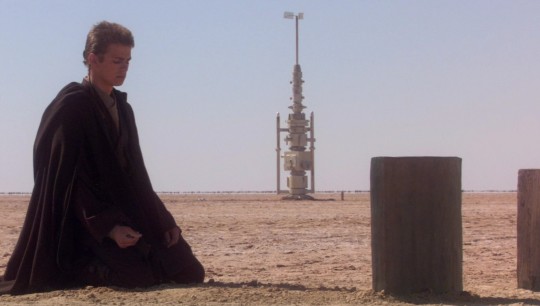
If this is all the fan in the audience is looking for, a faded echo of their favorite memory, then perhaps that is enough. But for those who do not share the reassuring memory, or those who look forward to the future and how things might change for the better, the ending of the Skywalker Saga offers only knowledge that all things fade and die. Without the lens of nostalgia, the Sequel Trilogy is merely an empty tale of death.
#star wars meta#sequel trilogy#star wars sequel trilogy#sequel trilogy meta#tros meta#tros#the force awakens#the last jedi#the rise of skywalker#skywalker saga#star wars#rey#rey of jakku#jakku#tatooine#death star#ruins#a saga in ruins#luke skywalker#princess leia#general leia organa#han solo#shmi skywalker#lars homestead#nostalgia#jj abrams#star wars criticism#millenium falcon#legacy lightsaber#anakin skywalker
401 notes
·
View notes
Text
“Why Do Fireflies Have To Die So Soon?”: A Tribute to Isao Takahata, 1935-2018
Isao Takahata has died at the age of 82. And while that name alone may not mean much to the average moviegoer, the news will come as a devastating blow to animation fans. As a producer, he co-founded the legendary Studio Ghibli with the legendary Hayao Miyazaki and would go on to collaborate with him on a number of his internationally celebrated films as a producer. That alone would be enough to earn a place of prominence in the pantheon of animation. But Takahata also directed a number of films on his own that would go on to equal success throughout the world, including “Grave of the Fireflies” (1988), a film that Roger Ebert once said “belongs on any list of the greatest war movies ever made” and “The Tale of Princess Kaguya” (2013), which earned him an Oscar nomination for Best Animated Feature. Without his efforts and influence over the years, it is safe to say that the animated film industry would be a markedly different beast than it is now, and definitely a less interesting one to boot.
Takahata was born in Ujiyamada, Mie Prefecture, Japan on October 29, 1935 and attended the University of Tokyo, where he studied French literature and graduated in 1959. Having developed an interest in animation earlier after watching the French film “Le Roi et l’Oiseau,” he was convinced by a friend to take the entrance exam at Toei Animation and was hired as an assistant director. After working in a number of positions on the various television programs and films put out by the studio, Takahata got the chance to direct his first feature film, “Hols: Prince of the Sun” (1968). While he was not an animator himself, his production team included Yasuo Otsuka as Animation Director and, in his first major film work, Miyazaki as Scenic Designer and Key Animator. Alas, the resulting film was a commercial and led to Takahata’s demotion at the studio.
In 1971, Takahata, along with Miyazaki and fellow animator Yochi Kotabe, left Toei. After an attempt to produce an animated version of “Pippi Longstocking” fell through, he went to work in television for Nippon Animation for the next decade. In 1981, he joined Otsuka at Telecom Animation Film Co. and directed both an adaptation of the popular manga Jarinko Chie and a subsequent TV spinoff. However, while Takahata was hired to direct “Little Nemo,” which was intended to be a collaboration between Telecom and Disney Studios, the project fell apart and led to his resignation from the company. Takahata soon bounced back when he was invited by Miyazaki to join the new animation company that he was forming, Studio Ghibil. Although the first film to come from this collaboration, the Miyazaki-directed, Takahata-produced fantasy epic “Nausicaa of the Valley of the Wind” (1984) is usually considered a Studio Ghibli film, it was actually made before the new studio was formed and released by Toei. The film was a critical and commercial hit, now considered one of the greatest animated features of all time, and their next collaboration, “Castle in the Sky” (1986), the official Ghibli debut, proved to be just as successful.
In 1988, Takahata directed his first feature for Ghibli, “Grave of the Fireflies.” The result was one of the most powerful movies of any type to be released during the decade. Based on a short story by Akiyuki Nosaka, it tells the story of a young boy named Seita and his younger sister, Satsuko, as they struggle to survive on their own after their home in Kobe is destroyed during the ending days of World War II after an American aerial bombing attack that takes the life of their mother. For a while, they stay with an aunt but when her resentment towards them grows as the food rations shrink, they take off once again and make a home of sorts for themselves in a hillside cave. There, Seita tries to both find food for the two of them and answer Satsuko’s increasingly difficult questions about what is going on and where their parents are.
Needless to say, the story does not end happily—the film is actually structured as a flashback by Seita’s spirit—and for American audiences raised on the belief that all animated films were inherently made for all ages, to see that art form service such a sad and wrenching of a narrative as can be imagined must have come as a shock. However, the use of animation to tell this particularly store proves to be an inspired choice. The stylization of the visuals means that moviegoers are free to remove themselves from the overtly and sometimes overwhelming trappings of this kind of filmmaking—the sets, special effects and booming action sequences—in order to put the focus more directly on the emotional underpinnings of the story. (Both Takahata and Nosaka survived air raids as children and you can feel the pain, confusion and wonder that they must have themselves felt throughout.) At the same time, there are moments of extraordinary visual beauty to be had here as well, the most famous of which is a lovely set of images when the siblings collect and release fireflies in their cave in order to illuminate the place. Yes, it builds to one of the saddest endings of any film that you will ever see. But you come away from it feeling a sense of elation at having witnessed the sight, however grim, of a film that is as perfectly done as one could hope for it to be.
While Takahata’s subsequent directorial efforts would not match the grimness of “Grave of the Fireflies,” they would nevertheless challenge most conventional notions of the kind of storytelling that one could do in the animation genre. “Only Yesterday” (1991), for example, was a gentle drama centered around Taeko, a 27-year-old unmarried woman who takes a few days off from her life in the city to go out to the country to help her brother-in-law’s family with a harvest and finds herself flashing back to memories of her own childhood in 1966. Again, this would seem to be an odd choice of subject matter for an animated film. But Takahata justifies it with an ingenious stylistic gambit in which the modern sequences and characters are rendered in an atypically realistic manner, while her childhood is presented in a look that more closely adheres to the conventions of anime.
Between that and the touching storytelling, in which memories of Taeko’s not-always-carefree coming-of-age are juxtaposed with her concerns about what she has become, the end result is another striking and fascinating work that would go on to be enormously popular in Japan (it was the country’s biggest homegrown hit of that year) and hailed as a masterpiece by critics. About the only place it wasn’t celebrated was the United States of America because, aside from a couple of festival screenings and an airing on Turner Movie Classics in 2006, it was never released there. The story goes that Disney, which had the distribution rights in America to Ghibli’s films for years, objected to a scene involving Taeko menstruating and since they could not simply cut it out due to the details of their contract with Ghibli, they instead elected to simply not screen it at all. (Happily, distributor GKIDS got the rights to Ghibil’s output in 2015 and released it the next year, with a new dub featuring the voices of Daisy Ridley and Dev Patel, to much rejoicing.)
Based on a story idea from Miyazaki, “Pom Poko” (1994) is a somewhat more conventional animated fantasy in which a group of raccoon dogs with magical abilities, such as being able to shape-shift, who try to prevent their forest home from being destroyed in the name of urban development. Although quite funny in spots, this is not merely an empty-headed kiddie film by any stretch of the imagination—it gets fairly serious at times. It is safe to say that an ordinary children’s film would have designed the main characters so that their testicles did not play such a key part in both the dramatic and visual design. “My Neighbors, The Yamadas” (1999) was another interesting blend of comedy and drama that, through a series of vignettes covering the gamut from the silly to the serious involving a typical middle-class Tokyo family that will ring true with viewers of all ages and nationalities. In 2003, he contributed a brief bit of animation to “Winter Days,” a collection of pieces inspired by winter days in Japan.
Takahata’s final directorial effort was “The Tale of the Princess Kaguya” (2013), an inspired fantasy that begins when an elderly couple find a tiny girl inside a bamboo shoot and raise her as their own. She grows in stature and beauty and virtually everyone who encounters her falls in love with her. The sons of five important families all propose marriage to her but when she orders them to finds proper gifts for her, they fail. However, when the Emperor of Japan himself turns up with a proposal of his own, it leads to a set of circumstances that force Kaguya to finally come to terms with herself and her parents about who she really is. The film is pretty extraordinary in all areas—visually stunning, dramatically powerful and deeply moving without ever becoming cloying or manipulative—and is easily Takahata’s best since “Grave of the Fireflies” and one of the finest of all Studio Ghibli films. It would go on to win numerous awards throughout the world and even won an Oscar nomination for Best Animated Feature, though it would lose to the Disney behemoth “Big Hero 6.”
Takahata’s final film work found him serving as producer of “The Red Turtle” (2016), an innovative fantasy about the interesting relationship that develops between a shipwrecked sailor and a mysterious red turtle who appears on the small tropical island where he washes up. If I tell you what happens next, you’ll write it off as a joke, but it is anything but that. This film would also go on to receive accolades and an Oscar nomination as well. There were rumors he may have been working on something new, but he had reportedly been in poor health recently and developed a heart condition last year.
Of course, when the subject of great Japanese animated filmmakers comes up, Miyazaki is the name that most people are going to gradually gravitate towards, in the same way that people in America will instantly conjure up Disney. However, Isao Takahata was no mere Saleri who was cursed to constantly stand in the shadow of greatness. He was a master of the art of animation as well and his contributions to the genre cannot possibly be overstated. The best way to prove this, of course, is to go out and check out his movies for yourself. Not only are his Ghibli productions all currently available via beautifully produced DVDs and Blu-rays, American audiences will have a chance to see “Pom Poko” and “Grave of the Fireflies” on the big screen, where they truly belong, as part of a monthly program of Ghibli films appearing in theaters across the country this summer—the former screens June 17, 18 and 20 while the latter plays on August 12, 13 and 15. There can be no greater tribute to Takahata and his work than to go and see these films and experience the magic that he created so effortlessly through his work. That said, if you go to see “Grave of the Fireflies,” just remember to bring lots and lots of tissues with you.
from All Content https://ift.tt/2EnM2A0
0 notes